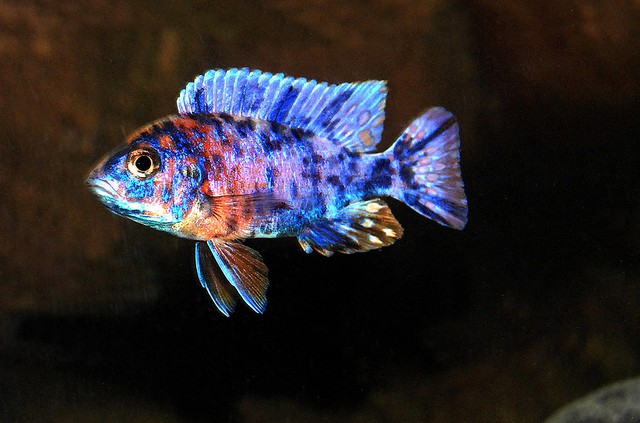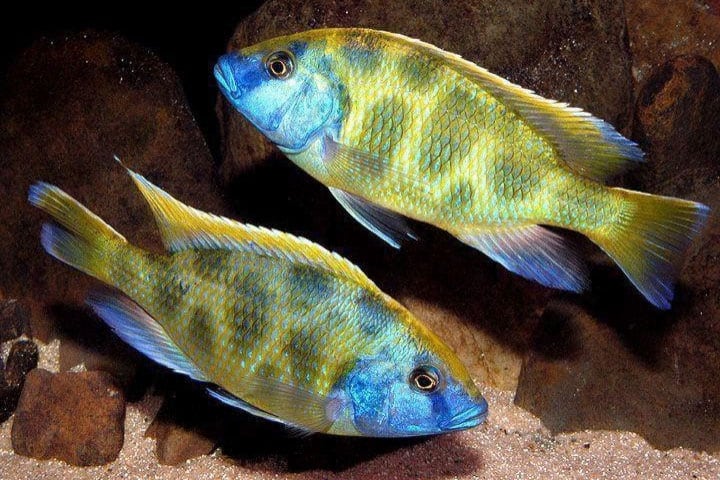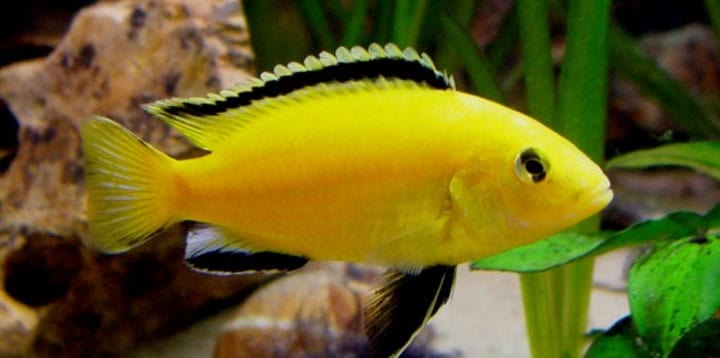There are 3 main types of cichlid tropical fish from Lake Malawi in the African rift valley; Mbuna, Aulonocara and Haplochromis. It is often thought that keeping Malawi cichlids means that you can just chuck any cichlid fish from lake Malawi in to a fish tank and that’s it. Technically it is a little more complicated than that and due to feeding habits and although they all live together in a huge lake (360 miles long and 25 miles wide) you should try and separate them in the home aquarium unless it’s really big!
It can be fine to keep them together however you need to be very cautious about the food you use and they would be more susceptible to catching Malawi cichlid bloat disease which can be tragic.
It is quite common to keep the Aulonocara (Peacock) cichlid together with Haps (Haplochromis) as these both have the same diet and tend to swim more in open water although rock work is still essential in the aquarium. The third type being Mbuna and although they are primarily a vegetarian, getting their nutrition from grazing on rocks, feeding them some of the essentials that the Peacock’s and Haplochromis require can lead to problems.
Aulonocara Cichlids (Peacock)
Often referred to as the Peacock cichlid, the Aulonocara is essentially one fish which has many colour variants depending on where it has come from in the lake although some are very similar to others. It is quite common to have them cross breed due to females all looking almost identical and are just grey in colour. This can result in some quite wonderful looking fish which are normally referred to as “OB Peacock”. Technically these are hybrid however if we want to start getting picky, aren’t all of these fish hybrids as they are all one fish but have evolved and become different colour formations over the years.

The Aulonocara species of cichlid from lake Malawi tend to be found around rocky and sandy areas as they will generally feed from the sand itself. They do this by hovering a few centimetres above the surface of the sand and remain motionless until they detect small movements within the sand through their very sensitive small pores at the base of the head. When such movement of their prey is detected they will pounce and secure the meal they have been waiting so patiently for.
Haps (Haplochromis)
Haps, for want of a better name, are basically a non-Mbuna flock that are informally called Haps because many of these fish once belonged to the broad genus Haplochromis Hilgendorf.

Most Haps are piscivores, unlike the vegetarian Mbuna. There are some exceptions to this generalisation, however, but these do well on a piscovore’s diet nonetheless. Haps are aggressive, but not as aggressive as the vegetarian Mbuna. They have long, slender, almost torpedo-like bodies, and cruise the open water. Most of these fish are silver or gray when small, and the males become very brightly colored as they mature. Females typically remain without colour.
Mbuna Cichlids
The Mbuna are a large group of rock-dwelling Cichlids that live among large piles of rocks along the shoreline. They are usually seen in large groups, but are by no means a schooling fish. In some areas of Lake Malawi, 20 fish per square meter is not uncommon. Both sexes of the more than 100 species of Mbuna are unusually colourful, whereas typically, only males have colour. They are very colourful with bright patterns of horizontal stripes or vertical bars. Mbuna are smaller and tend to have flat faces, which enables them to better scrape algae from rocks.



Related Posts
A Deeper Look In To Loach Fish Species
How Much Salt Should I Add To My Freshwater Aquarium
Everything You Need To Know About Using T5 Lights For Your Aquarium